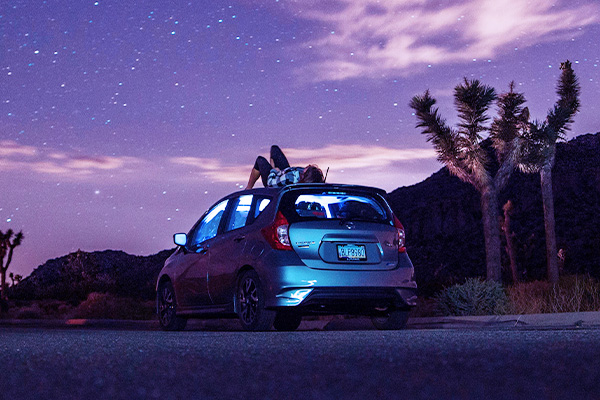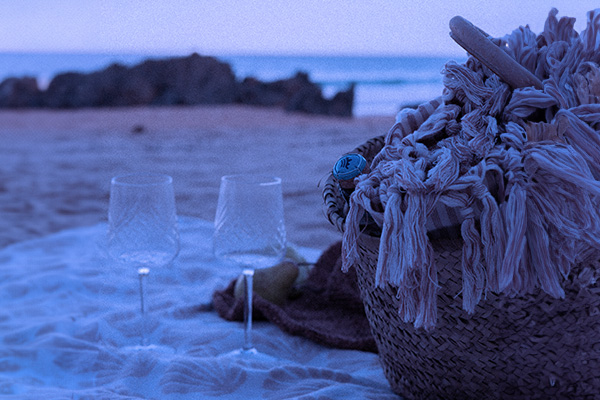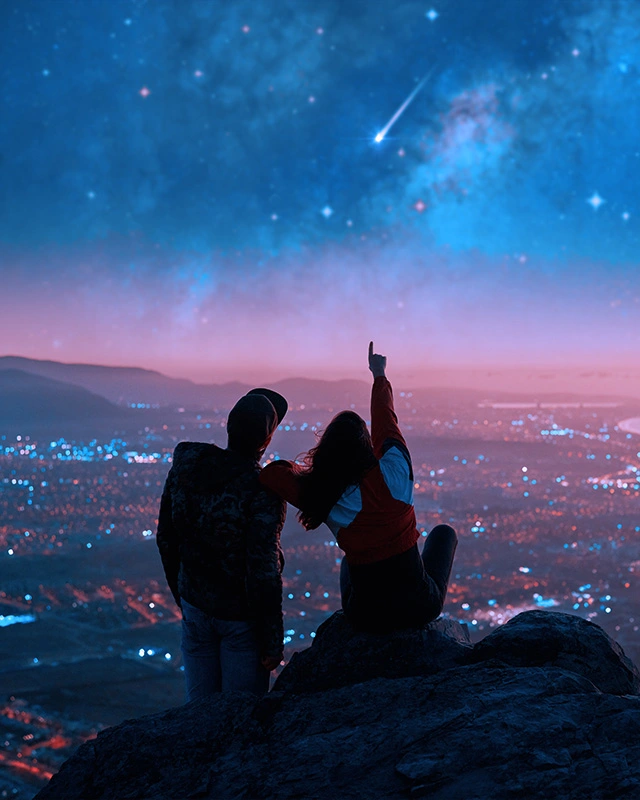As algorithmic browsing continues to dominate much of our lives, there’s something refreshingly analog about snuggling on a blanket under a canopy of stars. A stargaze picnic offers an opportunity to disconnect from much of the digital world and at least acknowledge the vastness of the universe above you—and, while you are at it, it’s a perfect way to connect with the person next to you. It’s a first date that combines the allure of the simple picnic with that feeling of smallness when confronted with the expanse that is the cosmos. It’s the kind of moment that sets the scene for reflection, intellectual discourse, and intimate connection.
The concept behind the stargaze picnic is deceptively simple: pack a basket, grab a blanket, and find a suitable spot away from the harsh glare of excessive urban light pollution. But like any worthwhile endeavor, the devil—and much of the delight—resides in the details. This isn’t an ordinary park or riverside picnic, nor for that matter, is it a stuffy astronomical society meeting. It’s a negligibly curated experience combining sensual pleasures such as fine food and drinks with amateur surveying of the night sky.
But let’s start with location. The key is escaping the city’s luminous haze, but not so far that you’re fumbling in complete darkness. Here are five U.S. cities that offer prime stargazing opportunities within reach:

The “Astronomy Capital of the World”
Just a short drive from downtown Tucson lies Oracle State Park, an International Dark Sky Park. Here, the Sonoran Desert’s arid climate ensures clear skies most nights, offering unparalleled views of the Milky Way. For a truly unique experience, time your visit with the park’s monthly star parties, where local astronomers set up telescopes for public viewing.
America’s First International Dark Sky City
Flagstaff takes stargazing seriously. The entire city has strict lighting ordinances to preserve the night sky—head to Buffalo Park, just minutes from downtown, for a 360-degree view of the heavens. The Flagstaff Dark Skies Coalition often hosts events here, combining astronomy with local craft beers—a perfect blend of science and socializing.
Desert Nights and Sculptural Delights
This small town, surrounded by Anza-Borrego Desert State Park, offers some of the darkest skies in Southern California. For a surreal experience, set up your picnic near one of the 130 metal sculptures scattered throughout the desert. These massive art installations, created by Ricardo Breceda, take on an otherworldly quality under starlight.
Acadia’s Celestial Coast
Just outside Bar Harbor, Acadia National Park hosts the annual Acadia Night Sky Festival in September. But any clear night offers spectacular viewing. Sand Beach provides a romantic setting with waves as a backdrop to your stargazing. For a more elevated experience, drive to the summit of Cadillac Mountain—the highest point on the eastern seaboard.
Red Rocks and Celestial Wonders
Nestled between Arches and Canyonlands National Parks, Moab is a stargazer’s paradise. Dead Horse Point State Park, about 30 minutes from town, offers panoramic views of the Colorado River daily and unobstructed celestial vistas by night. The juxtaposition of otherworldly rock formations against the star-studded sky creates a truly unforgettable backdrop for a date.
Now: provisions. This isn’t the time for a heavy, sleep-inducing feast. Instead, select light, flavor-packed bites that won’t distract from the main event. Consider a charcuterie board with a difference: alongside the usual cured meats and artisanal cheeses, include some freeze-dried astronaut ice cream as a playful nod to space exploration. Pair it with a bottle of Napa’s finest, and choose a label with something that resembles a meteor shower or stars.
As for equipment, a sturdy blanket is essential. Skip the flimsy picnic throw and invest in something substantial that is water-resistant, made from recycled materials, and packs down small—ideal for impromptu stargazing sessions.

To elevate your celestial exploration, bring along a pair of binoculars. While a telescope might seem obvious, it can be cumbersome and intimidating for beginners. A good pair of 10×50 binoculars, like the Celestron SkyMaster, will reveal Jupiter’s moons and Saturn’s rings without breaking the bank or requiring a PhD to operate.
Of course, the modern stargazing experience is only complete with at least some technological assistance. The Star Walk 2 app is an excellent choice for neophyte astronomers. Simply point your phone at the sky, and it identifies constellations, planets, and even satellites in real time. For a more immersive experience, consider the Star Chart app, which offers a VR mode for compatible headsets.
But technology should enhance, not dominate, the experience. Remember to put the phone down and simply gaze upward. Contemplating the cosmos is profoundly humbling—a shared experience that can spark deep conversations and foster connection. Speaking of connection, let’s address the elephant in the galaxy: conversation. Stargazing provides natural pauses for reflection, making it ideal for those getting to know each other. Come prepared with a few celestial conversation starters:
- Did you know that we see the past when we look at stars? Light from Sirius, the brightest star in our night sky, takes 8.6 years to reach Earth. Some light reading on the subject matter may be helpful in preparation for the date.
- The color of stars can tell us about their temperature. Red stars actually run colder than blue ones.
- There are more stars in the universe than grains of sand combined on all of Earth’s beaches. And so on…
Factoids are launching points for discussions about our place in the universe, our hopes and dreams, or simply our favorite sci-fi movies. Of course, don’t overdo it. It’s a first date, not a lecture.
As for setting the mood musically, curate a playlist that enhances the ethereal atmosphere without overpowering it. Here’s an eclectic mix that spans genres and eras, providing a sonic journey as varied and awe-inspiring as the night sky itself:
- “Space Oddity” by David Bowie. It doesn’t get more classic—a weird, otherworldly song that somehow sounds fresh decades later.
- “Cosmic Love” by Florence + The Machine. It is an epic and romantic track written by the British band’s lead vocalist, Florence Welch.
- “Starman” by Seu Jorge. The Brazilian singer and actor gained recognition for his Portuguese covers of David Bowie songs, as featured in Wes Anderson’s 2004 “The Life Aquatic with Steve Zissou.”
- “Also sprach Zarathustra“, Op. 30, Richard Strauss. Strauss’s “Also Sprach Zarathustra” gained widespread recognition through Stanley Kubrick’s “2001: A Space Odyssey,” particularly its colossal opening with its stupendous brass-and-percussion bang and a celebrated skull-numbing organ blast.
- “The Planets, Op. 32: Jupiter, the Bringer of Jollity“, Gustav Holst. British composer Holst’s ‘The Planets’ represents all the known planets of the Solar System seen from Earth at the time, and their corresponding astrological character, including Jupiter and Mars.
- “Stardust” by Nat King Cole, composed by Hoagy Carmichael. A romantic classic.
- “Stars” by Nina Simone. A legendary live recording at Montreux and one of my favorites. Simone, in full glory, is at the height of her ample musical—and communicative—powers.
A stargaze picnic is more than just a first date—it’s an experience that puts daily concerns into cosmic perspective and a chance to ponder life’s BIG questions or simply enjoy comfortable silences in the presence of something greater than ourselves. And who knows? You may find real magic happens not in the skies but in a shared moment of awe and discovery—right here on Earth.








